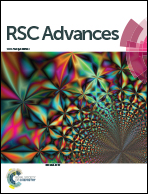Effect of bromide ions on the corrosion behavior of hafnium in anhydrous ethanol
Abstract
The electrochemical behaviors of hafnium (Hf) in Et4NBr ethanol solutions were investigated using cyclic voltammetry, potentiodynamic polarization, chronoamperometry, impedance and SEM techniques. The potentiodynamic anodic polarization curves did not exhibit an active dissolution region near the corrosion potential due to the presence of an oxide film on the electrode surface, which was followed by pitting corrosion as a result of the passivity breakdown by the aggressive attack of the bromide ion (Br−). The pitting potential (Eb) shifted to more positive values with increasing the scanning rate, but in a more negative direction with increasing the solution temperature and Br− concentration. The apparent activation energy was calculated as 27.074 kJ mol−1 by Tafel extrapolation. The current–time transients indicated that the incubation time for passivity breakdown decreased slightly with increasing Br− concentration and applied positive potential. The impedance spectra showed that the resistance of the passive layer and charge transfer decreased with an increase in Br− concentration and applied positive potential, while the resistance of the solution was nearly constant with increasing applied positive potential and decreased with increasing Br− concentration. The Hf surface morphology and the growth of pitting process were studied by SEM and the images confirmed the existence of pits on the Hf surface.


 Please wait while we load your content...
Please wait while we load your content...